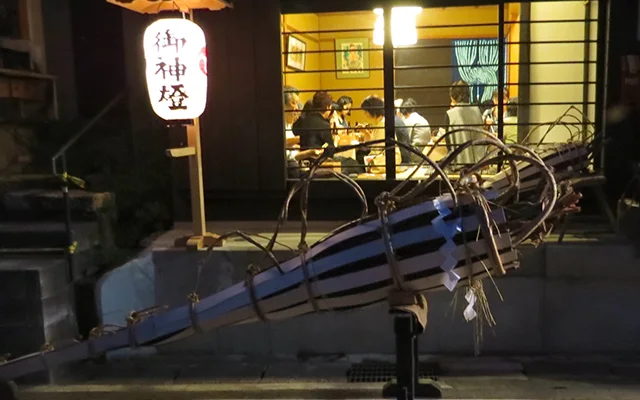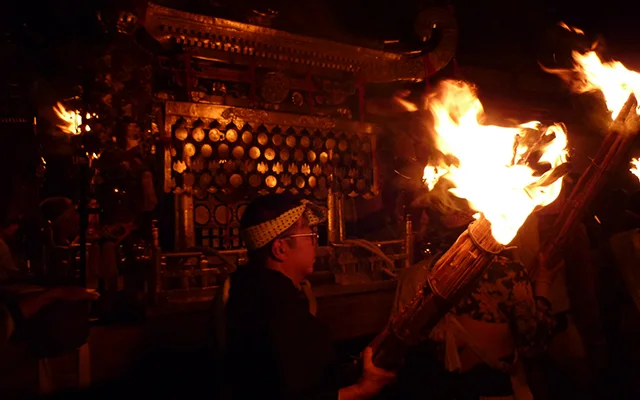Rituals and customs of the Kurama Fire Festival
A closer look at the distinctive customs and rituals followed during the festival which build-up an esoteric and magical atmosphere.
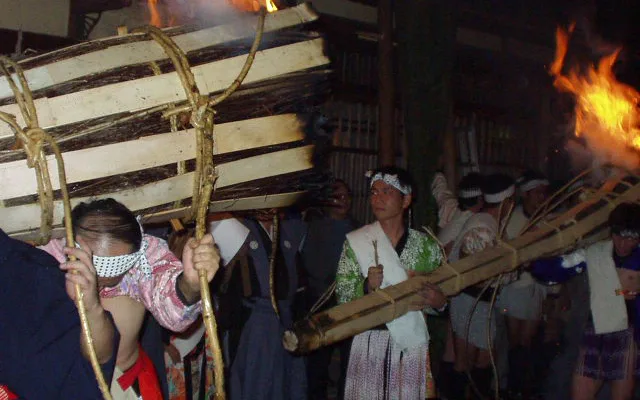
For those who find themselves in the area of Kyoto around the 22nd of October, visiting the Kurama Fire Festival is undoubtedly a highly recommended choice. Apart from the faithful who observe the festival for worshiping and praying reasons, there are many people from Japan and abroad who set Kurama village and its famous event as a major worth-visiting destination. Indeed, the Kurama Fire Festival offers the opportunity to observe a genuine and extraordinary ritual that reveals an interesting aspect of Japanese folklore and religion.
Observing the ceremonial rites and the fire parade that takes place on the 22nd of October at Kurama village is a unique experience with spiritual and cultural connotations. Local inhabitants and procession participants offer a magical and to a certain extent a bizarre show that has deep roots in the history of Japan. The followed rituals and customs are related to fundamental elements of the old Shinto religion which are considered as identical elements of the Japanese culture.
Basic elements and practices followed at Kurama Fire Festival
Below you can find a list with the most significant aspects and characteristics of the Kurama Fire Festival. A deeper look in the principals of the feast reveals the fundamentals of the ancient Shinto religion and certifies their long tradition and influence within Japanese society.
Bonfires (kagaribi 篝火)
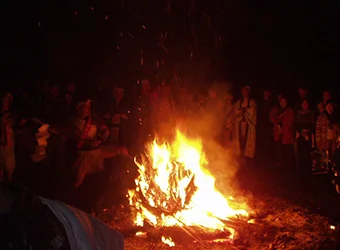
The ritualistic festivities of the Kurama Fire Festival start at sunset when the local inhabitants of Kurama village lit up bonfires, known as kagaribi (篝火), in front of their houses and other traditional buildings of their small community.
The sparkling light of the fires illuminate the evening dusk environment and introduces the festival observers to the solemn concept of the occasion. Parallel to that, the villagers decorate their houses by exposing their family heirlooms and antiques at their windows and house yards. Those objects can be samurai armors, crockery, as well as paintings and they construct a scenery that travels the visitor to a past era.
Traditional garments
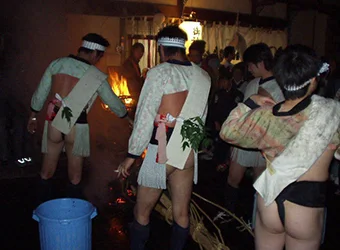
The Kurama Fire Festival is by definition a feast where the Japanese folklore is celebrated to its greatest extent.
This is expressed not only through the vivid rituals and the followed processions but also through the clothing and the costumes worn by the parade participants. All the parade members are dressed in traditional costumes and keep the typical accessories that people used to carry back in the 10th century.
Regardless of the weather circumstances, they wear, among others, minimal traditional costumes (loincloths), warrior’s sandals, and braided rope skirts tied around the waist. The men who are responsible to carry the big torches that can weight up to 100 kilos are used to have a padded cloth slung over their shoulder as a cushion for the heavy torch.
Fire torches (taimatsu 松明)
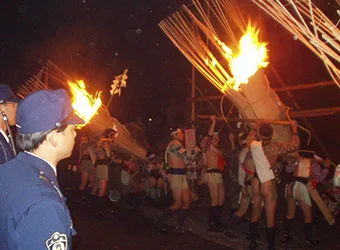
The verbal commandment “Shinji ni mairasshare!” (come and visit the festival) that is yelled at 6 o’clock in the evening is the official kick-off call of the festivity. At that time, all the bonfires and the fire torches are lit up and their sparkling light dominates in the evening darkness. Similar to the procession carried more than 1000 years ago, when the Yuki Shrine moved from the day’s capital to Kurama mountain, the contemporary reenactment implicates that the fires are those which facilitate the spirits to find their way to the Shrine.
Small and bigger fire torches are carried by the procession participants who gladly scream “saireya sairyo!” (have a good festival!) and move slowly towards Yuki Shrine. The smaller torches are carried by children and teenagers, while big homemade pine torches that weight up to 100 kilos are carried by groups of adult men. At 8 o’clock, in one of the most culminating timings of the festivity over 250 torches reach the gate steps of the Yuki Shrine and offer a spectacular show.
Hundreds of participants raise their torches to the sky and some minutes later the “Cutting the Sacred Rope” ceremony is followed. When the sacred rope that runs across the gate of the Shrine is cut, it is time for the portable shrine (mikoshi) to descent from the Shrine.
Fire parade

As mentioned above the fire parade starts some minutes after 6 o'clock when all the fire torches and bonfires are lit up. The majority of the procession’s participants are younger members of the Kurama community since the parade is also considered as a rite of passage for the youth.
Originally, it was a ritual carried out only by male children and teenagers of the village but later on, due to the decreasing population of the community, girls started to participate as well.
The parade starts just outside the Kurama train station and passes through the main street of the village towards the Yuki Shrine. The first line of the procession includes the younger children with small fire torches, then the teenagers follow and last come the adult men carrying the big fire torches which weight around 80 to 100 kilos. The sounds of the “taiko” drums that accompany the parade, the fire torches and the participant yelling “saireya sairyo” (have a good festival) who wish to the attendants, build up an esoteric and mysterious atmosphere that characterizes the event.
Portable Shrine (mikoshi 神輿)
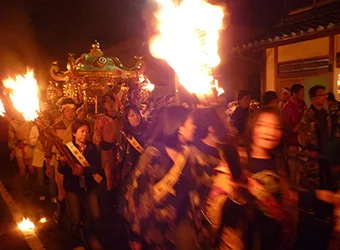
Some minutes before 9 o’clock, and after a praying ceremony, the portable shrine (mikoshi) leaves the Yuki Shrine and is carried downhill towards the village and more specifically to Otabisho area. The mikoshi is a portable structure with four poles that resembles a Shinto shrine. It is very heavy and participating in its transfer is considered as a very demanding task.
According to the tradition as the mikoshi goes down the hill-steps on the shoulders of adult men some teenagers dressed in traditional loincloths may hang from its poles. It is the so-called “Choppen Ceremony” that signifies the passing to adulthood for men in Kurama. Similarly, young women are pulling a rope that is attached to the mikoshi and slows down its descent moving from the hill. It is said that this practice helps women to deliver their children safely.
When the mikoshi arrives in Otabisho district at around midnight, a Kagura performance is given as an offering to the gods and afterwards the portable shrine is carried back to the Yuki Shrine.
